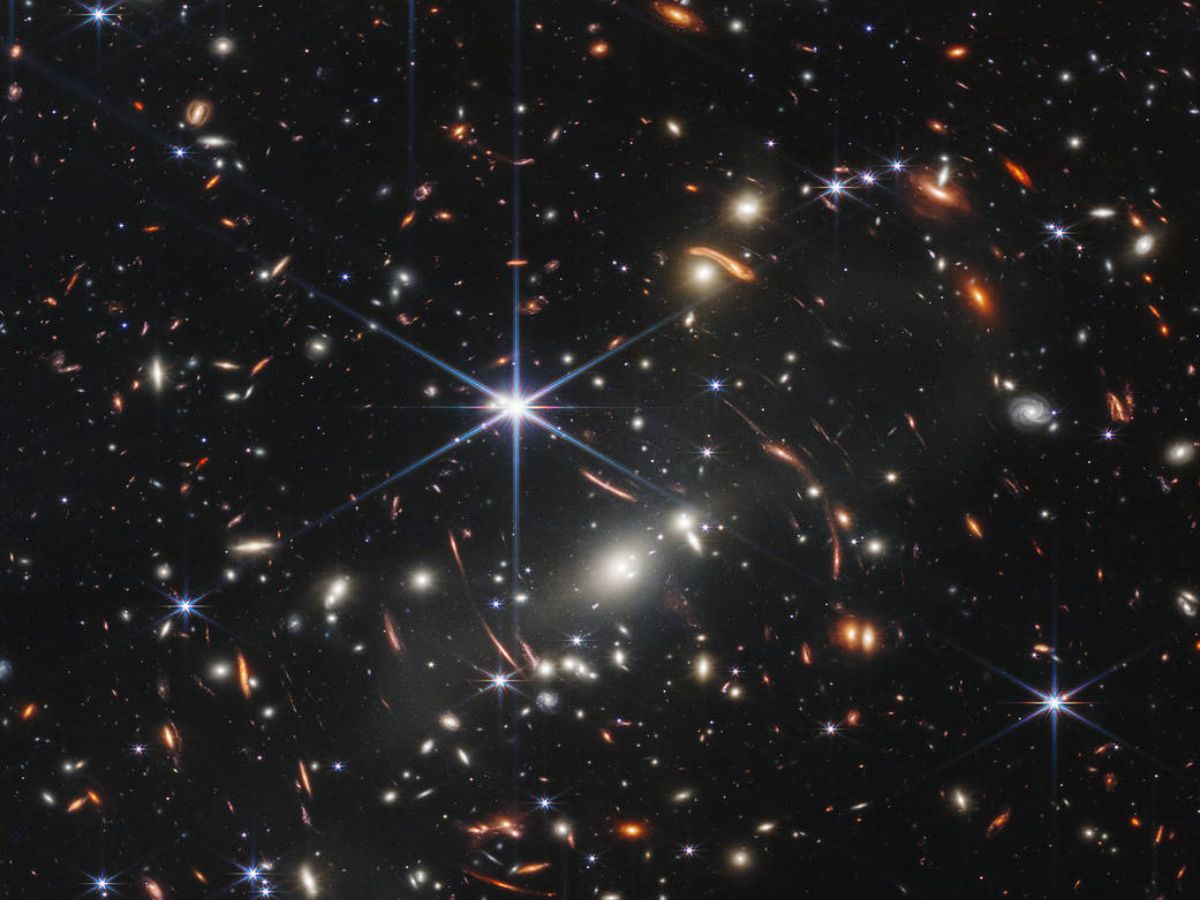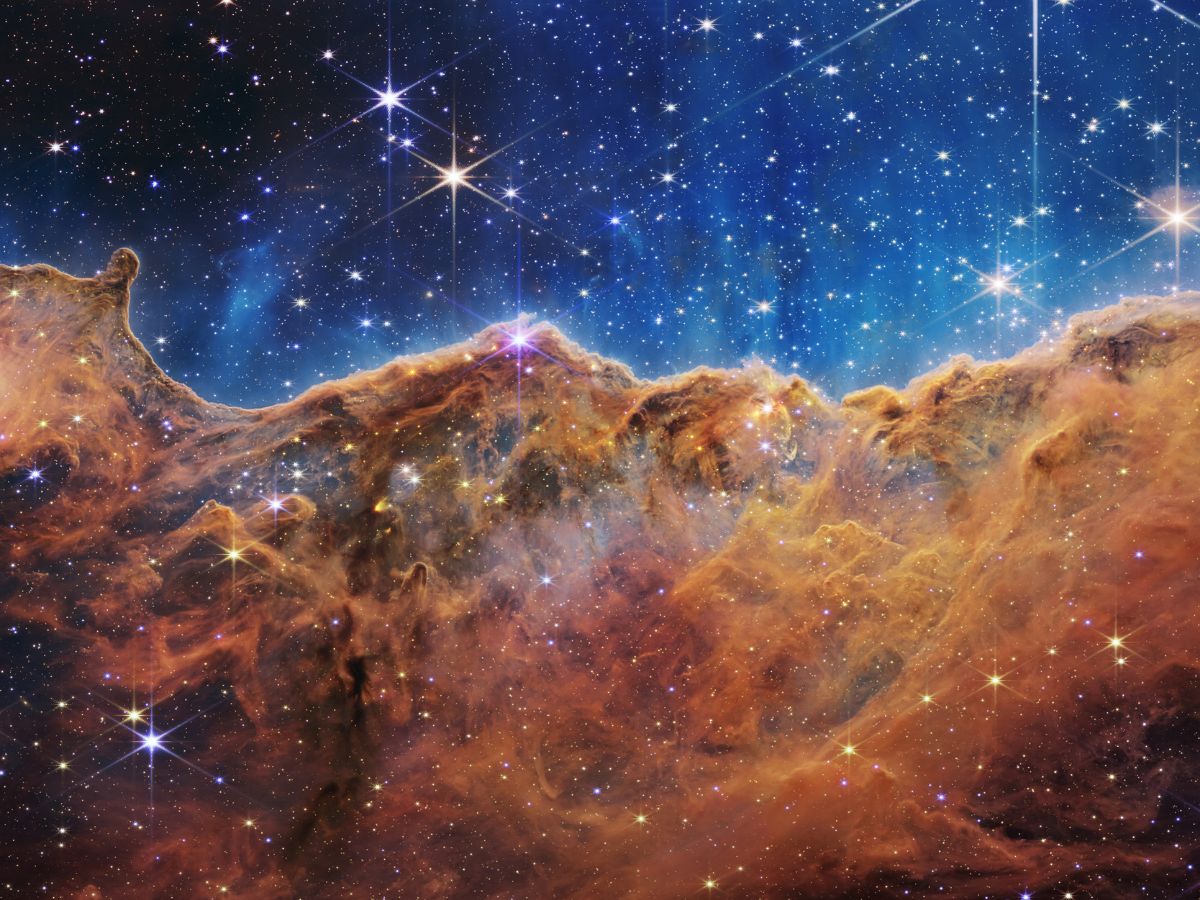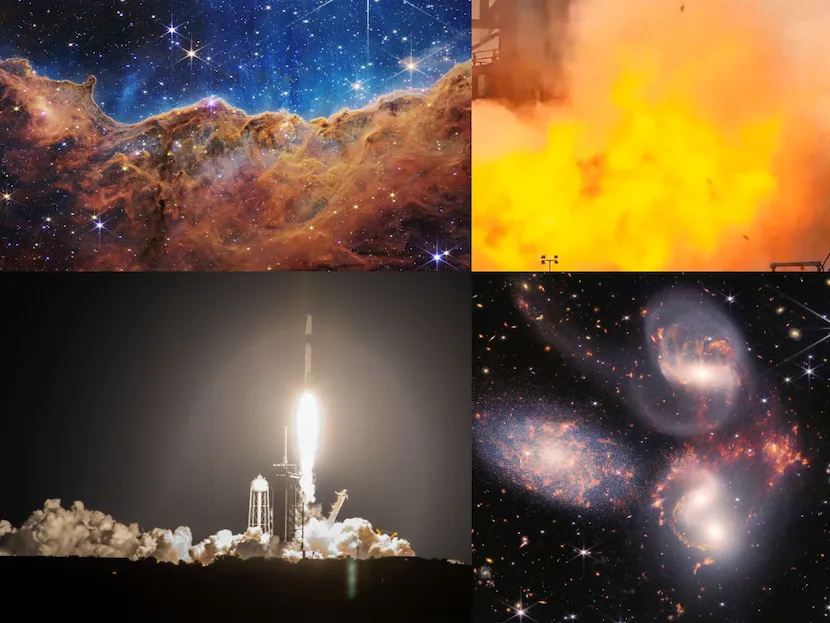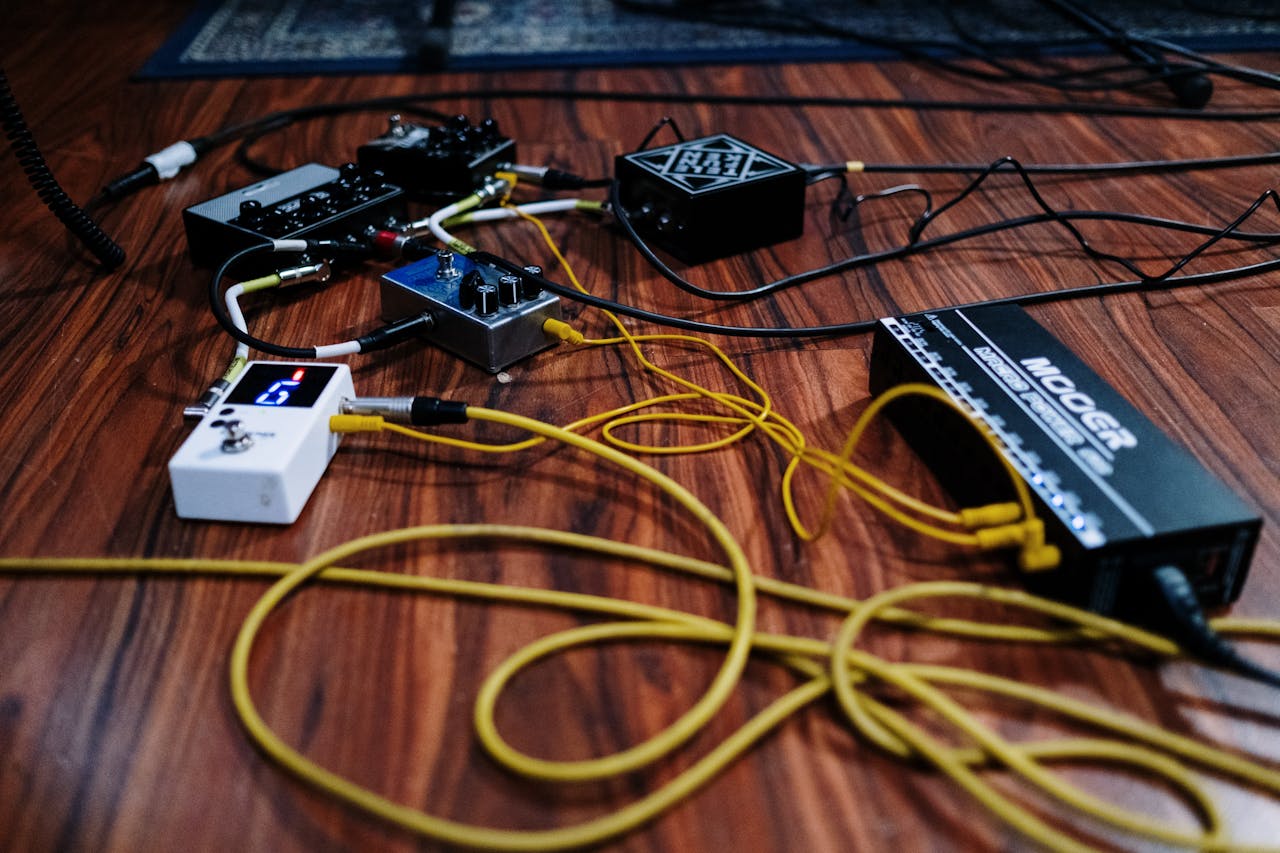[ad_1]
The previous week was an important week for space and astronomy because several milestones were achieved in these fields. On July 12, 2022, NASA unveiled the first full-colour images from the James Webb Space Telescope. NASA also released Webb images of Jupiter, its moons, and ring, and of Asteroid 6481 Tenzing. A SpaceX Crew Dragon spacecraft carrying science experiments, crew supplies and other cargo was launched to the International Space Station (ISS) on July 15. The Dragon spacecraft docked into the space station on July 16, and will remain there for about a month.
Here are the top developments in space from last week.
Page Contents
NASA, Roscosmos Sign Agreement To Integrate Flights To International Space Station
Last week, NASA and the Russian space agency, Roscosmos, signed an agreement to integrate flights to the ISS. This will allow Russian cosmonauts to fly on US-made spacecraft, while American astronauts will be able to ride on Russia’s Soyuz spacecraft, news agency Reuters reported.
Roscosmos said in a statement that the “agreement is in the interests of Russia and the United States and will promote the development of cooperation within the framework of the ISS program”. The Russian space agency added that it will facilitate “the exploration of outer space for peaceful purposes”.
NASA and Roscosmos are the two-decade-old space station’s core partners. For years, the US and Russian space agencies have sought to renew routine integrated crewed flights to the ISS as part of their long-standing civil alliance.
According to the Reuters report, NASA said that the first integrated flights under the new agreement will take off in September this year. US astronaut Frank Rubio will be flying to the space station from the Moscow-leased Baikonur Cosmodrome in Kazakhstan alongside two Russian cosmonauts, Sergey Prokopyev and Dmitry Petelin.
Russian cosmonaut Anna Kikina will be flying to the space station with two US astronauts and a Japanese astronaut as part of the agreement. They will be launched to the orbital laboratory from NASA’s Kennedy Space Center in Florida.
SpaceX Commercial Resupply Mission To International Space Station
A SpaceX Crew Dragon spacecraft carrying science experiments, crew supplies, and equipment launched to the ISS on July 15 at 6:14 am, from Launch Complex 39A at NASA’s Kennedy Space Center in Florida, as part of SpaceX’s 25th commercial resupply mission for NASA.
The spacecraft docked into the forward-facing port of the space station’s Harmony module on July 16 at 8:51 pm IST.
The space experiments delivered to the space station include the Earth Surface Mineral Dust Source Investigation (EMIT), the Immunosenescence investigation, Dynamics of Microbiomes in Space, BeaverCube, Genes in Space-9, and Biopolymer Research for In-Situ Capabilities.
Earth Surface Mineral Dust Source Investigation (EMIT)
EMIT has been developed by NASA’s Jet Propulsion Laboratory. It employs NASA’s imaging spectroscopy (study of absorption and emission of light and other radiation by matter) technology to measure the mineral composition of dust in Earth’s arid regions. The science experiment will collect images for one year to generate maps of the mineral composition in the regions on Earth that produce dust. Studying these regions is important because mineral dust blown into the air can travel significant distances and affect Earth’s climate, weather, and vegetation.
Immunosenescence Investigation
The Immunosenescence investigation has been sponsored by the International Space Station US National Laboratory. The science experiment uses tissue chips to study how microgravity affects immune function during flight and whether immune cells recover post-flight. Scientists can use tissue chips, which are small devices containing human cells in a 3D structure, to test how human cells respond to stresses, drugs, and genetic changes.
The significance of the investigation is that scientists will be able to study the speedier immune system ageing in space. Ageing is associated with changes in the immune response known as immunosenescence, and microgravity causes changes in the human immune cells that resemble this condition, but happen faster than the actual process of ageing on Earth.
Dynamics of Microbiomes in Space
Dynamics of Microbiomes in Space is an experiment sponsored by NASA’s Division of Biological and Physical Sciences. It examines how microgravity affects metabolic interactions in communities of soil microbes. The significance of the research is that it will study microbe communities that decompose chitin, a natural carbon polymer on Earth. Microorganisms play an important role in soil by cycling carbon and other nutrients and supporting alcohol plant growth.
BeaverCube
BeaverCube is an education mission that will teach high school students aerospace science by having them design a CubeSat, and will host one visible and two infrared imagers to measure cloud properties, ocean surface temperatures, and ocean colour to study Earth’s climate and weather systems.
Genes in Space-9
Genes in Space-9 is an experiment sponsored by the National Laboratories, Department of Energy, United States. The experiment promotes cell-free technology, a platform for producing protein without specialised equipment of living cells that need to be cultured.
Genes in Space-9 demonstrates cell-free production of protein in microgravity, providing a simple, portable, and low-cost tool for medical diagnostics, production of medicines and vaccines, and environmental monitoring on future space missions.
Biopolymer Research for In-Situ Capabilities
Biopolymer Research for In-Situ Capabilities is a science experiment that looks at how microgravity affects the process of creating a concrete alternative made with an organic material and on-site materials. These materials could be lunar or Martian dust, known as biopolymer soil composite.
James Webb Space Telescope’s First Full-Colour Images Of The Unseen Universe
The world got its first look at the full capabilities of the James Webb Space Telescope last week, marking the dawn of a new era in astronomy.
The world’s largest and most powerful space telescope has captured the image of a galaxy cluster as it appeared billions of years ago, detected the presence of water on an exoplanet, revealed exceptional details of the Southern Ring Planetary Nebula, shed light on galaxy evolution and black holes, and unveiled ‘Cosmic Cliffs’ in the Carina Nebula.
The President of the United States, Joe Biden, unveiled the deepest and the sharpest infrared image of the distant universe to date. This was the first full-colour image to be released from Webb.
NASA quietly released two more Webb images. These are the images of Jupiter, the Jovian moons Europa, Thebe and Metis, and the gas giant’s ring. The pictures were captured while Webb was being tested, and have been provided in the JWST commissioning report.
Webb’s full-colour images reveal several secrets about the cosmos.
Webb’s First Deep Field

Webb has captured the galaxy cluster SMACS 0723 as it appeared billions of years ago. NASA unveiled Webb’s image of the galaxy cluster last week. Known as Webb’s First Deep Field, this image of SMACS 0723 is the deepest and sharpest infrared image of the distant universe so far.
The image is a composite made from images at different wavelengths, totalling 12.5 hours. According to NASA, the combined mass of the galaxy cluster SMACS 0723 acts as a gravitational lens, magnifying more distant galaxies. The powerful gravitational field of the galaxy cluster bent the light rays from the distant galaxies behind it, similar to a magnifying glass.
The data from Webb’s Near Infrared Spectrograph (NIRSpec), which observed 48 individual galaxies at the same time, revealed light from one galaxy that travelled for 13.1 billion years before Webb’s mirrors captured it.
This marks the first step towards Webb tracing galaxies back to the beginning of cosmic time.
WASP-96 b: Webb Detects Water In An Exoplanet’s Atmosphere

Webb has imaged the distinct signature of water, along with evidence for clouds and haze, in the atmosphere surrounding a hot, puffy, gas giant exoplanet called WASP-96 b.
The planet is orbiting a distant Sun-like star. Webb has revealed the steamy atmosphere of the distant planet in detail.
Webb’s enormous mirror and precise instruments have captured the most detailed measurements of starlight filtering through the atmosphere of WASP-96 b.
According to NASA, the spectrum of light, which contains information about the makeup of a planetary atmosphere 1,150 light-years away from Earth, reveals the distinct signature of water.
Webb’s detailed observation of the atmosphere of an exoplanet marks a giant leap forward in the search for potentially habitable planets beyond Earth.
Southern Ring Nebula: Webb Captures Dying Star’s Final Performance

Webb’s third image to be unveiled is that of the Southern Ring planetary nebula or the “Eight-burst Nebula”. The nebula is approximately 2,500 light years away from Earth.
According to NASA, planetary nebulae are the shells of gas and dust ejected from dying stars.
Through its third full-colour image, Webb has revealed details of the Southern Ring planetary nebula that were previously hidden from astronomers. Shells of gas and dust ejected from dying stars constitute planetary nebulae.
The powerful infrared view of Webb has brought the nebula’s second star into full view, along with exceptional structures created as the stars shape the gas and dust around them. The infrared view of the telescope also reveals details of the exceptional structures created as the stars shape the gas and dust around them.
According to NASA, new details from the late stages of a star’s life will help the world better understand how stars evolve and transform their environments. The image has captured the “final performance” of a dying star in fine detail.
A cache of distant galaxies can also be seen in the background. Most of the multi-coloured points seen in the image are galaxies, not stars.
The Southern Ring planetary nebula has been imaged using the Near-Infrared Camera (NIRCam) and the Mid Infra-Red Instrument (MIRI).
Two stars, locked in a tight orbit, shape the local landscape of the cosmic entity. The image from Webb’s NIRCam (left) shows the stars and their layers of light. Meanwhile, the image from Webb’s MIRI (right) shows for the first time that the second star is surrounded by dust.
Hundreds of stars and background galaxies are seen in the near-infrared image, while dusty planet-forming disks around young stars are seen in the mid-infrared image.
According to NASA, the brighter star, which is in an earlier stage of its evolution, will probably eject its own planetary nebula in the future.
The brighter star influences the appearance of the nebula. As the two stars orbit one another, they “stir the pot” of gas and dust. This causes asymmetrical patterns.
The dimmer star seen at the centre of the nebula has been sending out rings of gas and dust for thousands of years in all directions, and Webb has revealed for the first time that the star is cloaked in dust.
The world’s most powerful telescope can explore the expelling shells of gas and dust of ageing stars, from birth to death as a planetary nebula. These ageing stars may one day form a new star or planet.
Stephan’s Quintet: Webb Captures Dancing Galaxies

The fourth full-colour image is that of a galaxy group called “Stephan’s Quintet”. Through its fourth full-colour image, Webb has revealed never-before-seen details of Stephan’s Quintet. This visual grouping of five galaxies was prominently featured in the classic film, “It’s a Wonderful Life”.
Webb’s infrared view pierced through the shroud of dust surrounding the centre of one galaxy, to reveal the velocity and composition of the gas near its supermassive black hole.
Due to the close proximity of Stephen’s Quintet, astronomers can see galactic mergers and interactions. The image shows in rare detail how interacting galaxies trigger star formation in each other and how gas in galaxies is being disturbed.
Stephan’s Quintet was discovered by the French astronomer Édouard Stephan in 1877. It is located in the constellation Pegasus.
According to NASA, Webb’s image shows outflows driven by a black hole in Stephan’s Quintet in a level of detail never seen before.
Cosmic Cliffs In Carina Nebula

The fifth and final full-colour image captured by the James Webb Space Telescope is that of the Carina Nebula. The image reveals baby stars in the Carina Nebula, where ultraviolet radiation and stellar winds shape colossal walls of dust and gas.
Webb’s fifth and final full-colour image reveals emerging stellar nurseries and individual stars in the Carina Nebula.
The image is called “Cosmic Cliffs”, and is a seemingly three-dimensional picture. A landscape of “mountains” and “valleys” speckled with glittering stars can be seen in the image.
The landscape is the edge of a nearby, young star-forming region called NGC 3324 in the Carina Nebula. Webb has captured the image in infrared light.
“Cosmic Cliffs” reveals for the first time previously invisible areas of star birth. The image reveals the “glittering landscape” of star birth.
Webb’s extreme sensitivity, spatial resolution, and imaging capability helped capture the cosmic objects in the earliest, rapid phases of star formation.
NGC 3324 is located roughly 7,600 light-years away from Earth. Webb’s NIRCam and MIRI captured the star-forming region. The tallest peaks seen in the image are about seven light-years high.
Due to intense ultraviolet radiation and stellar winds from extremely massive, hot, young stars, a cavernous area has been carved from the nebula. The young stars are located in the centre of the bubble. The stars can be seen at the top of the image.
Therefore, Webb’s image unveils the earliest, rapid phases of star formation that were previously hidden.
Jupiter, Its Moons, Ring, And Asteroid 6481 Tenzing

Webb has tracked solar system objects at speeds more than twice the requirement. The telescope has detected faint galaxies and observed targets as bright as Jupiter.
The telescope tracked Jupiter using instruments such as NIRCam, NIRISS (Near-Infrared Imager and Slitless Spectrograph), and the MIRI MRS (medium-resolution spectrometer).
One of Webb’s programmes demonstrated that the telescope can track moving targets even when there is scattered light from a bright Jovian planet.
The NIRCam instrument captured two images of Jupiter. One of the pictures is a short-wavelength image while the other is a long-wavelength image.
In both the images, the Jovian moons Europa, Thebe and Metis can be seen. The shadow of Europa is also visible, just to the left of the Great Red Spot on Jupiter. The gas giant’s ring is faintly visible in the Webb images.
With the help of the NIRCam instrument’s short-wavelength filter, Webb has captured images of Jupiter showing the distinct bands encircling the planet as well as the Great Red Spot, a storm strong enough to swallow Earth. Because of the way in which Webb’s infrared image was processed, the iconic spot appears white in the picture.
Bryan Holler, a scientist at the Space Telescope Institute in Baltimore, who helped plan these observations, said in a statement that combined with the deep field images released the other day, these images of Jupiter demonstrate the full grasp of what Webb can observe, from the faintest, most distant observable galaxies to planets in our own cosmic backyard that one can see with the naked eye from their actual backyard.
On the left side of the image, Europa is clearly visible. This is a moon with a probable ocean below its thick icy crust, and the target of NASA’s upcoming Europa Clipper Mission.
The images are proof that Webb can observe the satellites and rings near bright solar system objects such as Jupiter, Saturn, and Mars, according to NASA. With the help of Webb, scientists will try to find out whether one can see plumes of material spewing out of moons like Europa and Saturn’s moon Enceladus.
The telescope may be able to see the signatures of plumes depositing material on the surface of Europa.
Also, some of Jupiter’s rings stand out in the NIRCam long-wavelength filter image. Stephanie Milam, Webb’s deputy project scientist for planetary science based at NASA’s Goddard Space Flight Center in Greenbelt, Maryland, said the rings shown in one of Webb’s first solar system images are “absolutely astonishing and amazing”.
According to NASA, Webb also obtained images of Jupiter and Europa moving across the telescope’s field of view in three separate observations, demonstrating the ability of the observatory to find and track guide stars in the vicinity of bright Jupiter. The three images have been taken through the NIRCam instrument’s 2.12 micron filter.
Webb has also captured an image of an asteroid called 6481 Tenzing, located in the asteroid belt between Mars and Jupiter.
The telescope used Asteroid 6481 Tenzing during commissioning to start the moving-target tracking “speed limit” tests.
SpaceX Starship Booster Explosion
SpaceX’s Booster 7 suffered a testing explosion on July 11. SpaceX CEO Elon Musk told news agency Reuters on July 13 that Booster 7 will be back on the launchpad in Texas soon. SpaceX plans to use the Starship rocket booster for an inaugural flight to orbit.
In an email to Reuters, Musk wrote that the damage is minor, but the booster will be transferred back to the high bay for inspections.
Booster 7 is the towering first half of SpaceX’s next-generation Starship rocket system. It was undergoing pre-launch tests on a stand last week, when its engine section burst into flames. This sent a shock wave miles across the South Texas facility.
[ad_2]
Source link












Leave a Comment